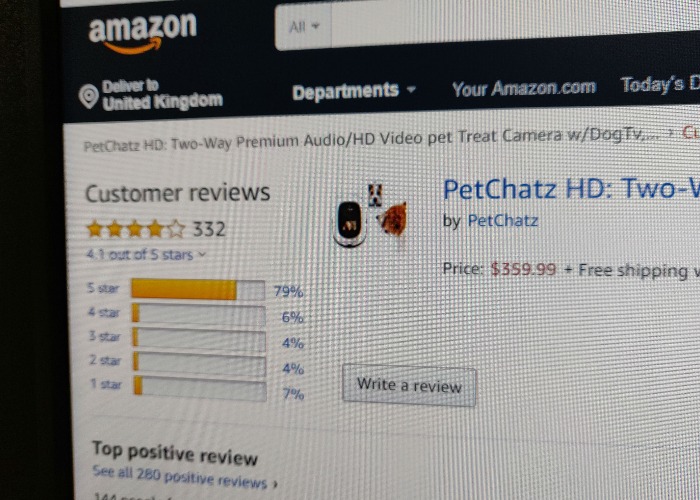Fake Amazon and TripAdvisor reviews: how to stay clear

Fake reviews are being churned out by the bucketload, pushing shoppers into wasting their cash.
One of the big causes of the apparent death of the high street has been the growth of online retailers.
One big benefit to shopping online is that you can quickly get an idea of how good a product is by reading the reviews before sticking it in your basket and paying for it.
That’s not something you get when popping down to the shops, and can help you make a more informed decision on whether that item is really the one you need.
In fact, more than half of UK adults make sure to read reviews before spending money, according to a study by the Competition and Markets Authority: that's £23 billion of spending a year.
However, there are big questions over whether these reviews are even worth looking at, as they are being manipulated by groups offering free products for positive reviews.
How to save money when shopping at Amazon
Rewards for reviews
The researchers at consumer champions Which? have put this to the test.
They set up dummy accounts on Facebook and Amazon to join some of the many ‘rewards for reviews’ groups on those sites, such as ‘Amazon Deals Group’ and ‘Amazon UK Reviewers’. Some of these groups had more than 87,000 members.
The idea is that once you review an item, you will be refunded for it through PayPal.
Five items were ordered and reviewed: wireless headphones, car fob signal blockers, a smartwatch, wireless earphones and a blood pressure monitor.
The researcher followed the groups' instructions on how long to wait before posting a review and then gave honest feedback based on their own experience of each individual product.

“It is the default to give five-star evaluation”
The trouble is, the people behind these groups aren’t looking for honesty - they are looking for positive reviews.
That’s why in three out of the five cases, the researcher didn’t get paid, despite following the specific instructions.
The smartwatch, for example, was given a two-star review but the researcher was told to bump it up to full marks. Because the refund would mean the item was free, they were told the “default” is to give a five-star review.
It was a similar story with the headphones, where the researcher was told that they would need to increase the three-star review to a five-star review if they wanted to be refunded.
Of course, Amazon and Facebook have both talked the talk here, saying that they won’t stand for these reviews, and urging users to report people they encounter on their sites encouraging this sort of dishonesty.
But let’s be honest, unless these tech giants actually want this to change - and do something about it, rather than relying on users - then nothing will happen.
23 online shopping hacks that will save you a small fortune
Fake reviews are all around us
As an unabashed mobile gamer, fake reviews are something I see an awful lot on the Google Play store.
Thankfully, they are pretty easy to spot - user after user giving a game five stars and posting reviews that are almost word-for-word identical, with the odd actual review in between that is rather more honest and forcefully worded.
But the point is that these fake reviews are everywhere.
For example, an investigation by The Times earlier this year suggested that as many as a third of all reviews on TripAdvisor are fraudulent, with a thriving black market allowing fake reviewers to make decent money fabricating positive experiences to share on the site.
Wherever there is the opportunity to leave a review, it appears that someone, somewhere is trying to game the system to make a few quid.

Spotting fake reviews
Thankfully, there are some things you can do to try to cut the fake reviews out and ensure you get a more accurate picture before spending your money.
For example, moving beyond the rating and actually reading the review will help you spot the shady ones. Iffy reviews often recycle the same keywords and points so if you start getting a sense of deja vu when reading it, it may be the result of one of these fake review groups.
It’s also worth looking at the profile of the reviewers themselves. Do they always give everything five stars? If so, this is a pretty good indication they may be a fake reviewer and that you can disregard them. Other things to look out for are whether they have bought more than one of the same type of item within a short period of time - you don't need a new set of wireless headphones every month.
Looking at the dates of the reviews is a good idea too. If there has been a glut of positive reviews within a small time period, this may be down to a push for shady reviews via these online groups. If the positive reviews are more spread out, then that’s less of a concern.
Scams: how spoofing, twitter clones, fake green padlocks and gift card 'fines' could catch you out
Amazon Verified Purchase
When shopping at Amazon, you may notice that some reviews are tagged as an 'Amazon Verified Purchase'. In theory, this should put your mind at ease, as it means that Amazon has confirmed that the user did, in fact, buy the item from the site.
However, given that the fake review groups often push the purchase of these products through Amazon, only to offer a refund later on through PayPal, you shouldn't entirely rely on the fact that a review has this tag as proof that it is above board.
Finally, there are some sites now which will analyse the reviews for specific products to give you an idea of how legitimate they may be. ReviewMeta, for example, covers Amazon reviews and offers an internet browser plus in to highlight fake reviews and give you an adjusted overall rating.
Meanwhile, FakeSpot covers everything from Amazon and TripAdvisor to app reviews: you paste in the product's URL and it analyses the reviews on the webpage.
These tools are automatic and so occasionally label genuine reviews as fakes, and have been criticised by TripAdvisor.
Most Recent
Comments
Be the first to comment
Do you want to comment on this article? You need to be signed in for this feature








